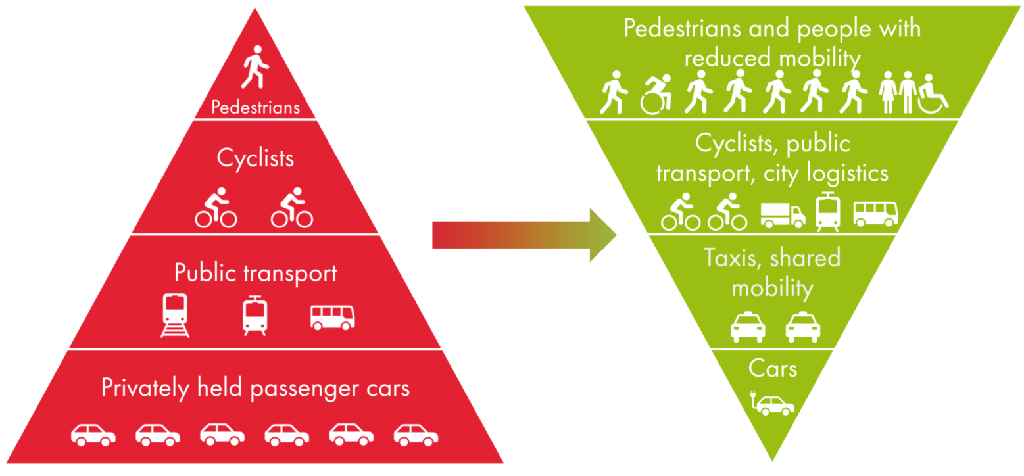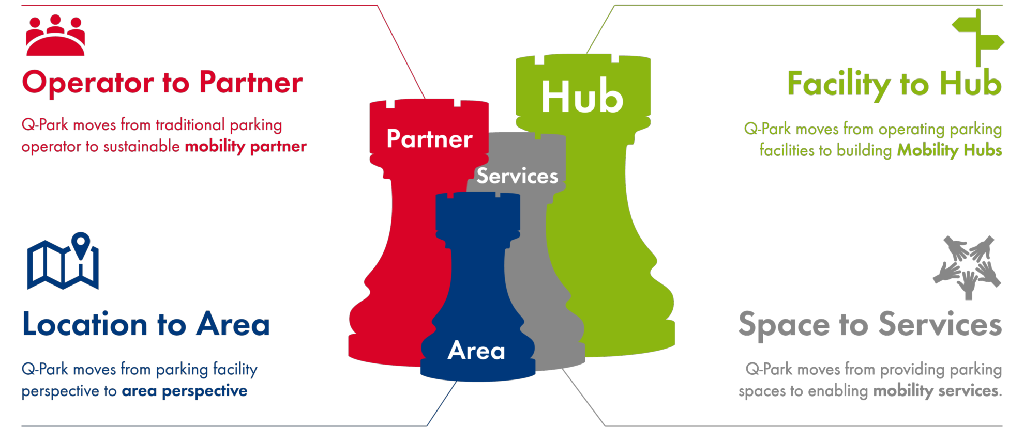SMP programme
Q-Park established its Sustainable Mobility Partner (SMP) programme in 2021 to support municipalities throughout Europe to address changing urban mobility needs. Many metropolitan areas and cities have adopted a sustainability agenda following publication of the European Union’s Green Deal and national government directives.
A sustainable urban mobility plan (SUMP) typically sets out a vision and outlines plans for transport and mobility in the wider urban area. A SUMP also encompasses a range of environmental targets and aims to develop all modes of transport concurrently and in an integrated manner, involving citizens and stakeholders alike.
In the long run, sustainable urban mobility will benefit the entire community as infrastructure is improved and movements in and around cities become more efficient. The knock-on effects, including more active mobility, lower emissions and greener urban areas, will also benefit public health and welfare.
Key shift in sustainability agenda
Sustainable mobility planning for the wider urban area involves focusing on people and individual mobility rather than on traffic. We see a shift from transport planning to mobility planning. And as the need for sustainable mobility increases, the focus is now shifting:
from cars to people (space & greenery);
from cars to active mobility (walking & cycling);
from owned to shared (car sharing & public transport);
from fossil fuels to electrification (EV cars & EV logistics).
Figure 20 Focus shift of sustainable mobility – from mass transport to individual mobility solutions

Q-Park as mobility partner
As part of our SMP programme, we have set ourselves the goal of analysing a large number of European cities and their SUMPs. We want to connect with urban ambitions as a mobility partner.
Q-Park’s sustainable mobility experts have noticed a trend to set targets and draw up plans which:
reduce emissions and pollution;
create accessible and liveable urban areas;
free up public space for people and greenery;
increase vitality as more people engage in active mobility and walk or cycle to their destination.
Mobility hubs are the solution
When we partner with municipal mobility planners, we take a step back to consider mobility and transport in the urban areas from a wider perspective. Rather than planning and making provisions for the various modes of transport separately, we know from experience that it makes sense to combine public and private modes of transport with public and private parking facilities.
We see areas emerging where people switch from one mode of transport to another. We can define these as residential, P+R and city hubs. These are the places where travellers switch between various modes of transport:
mass transit: train, tram, metro, bus;
private modes: taxis, shared or private cars;
active mobility: cycling or walking.
Mobility hubs link transport in urban areas
When transport nodes converge, they form a hub. For example, a bus stop is probably the smallest local hub. When a network of car parks is combined with a range of mobility options at multiple locations in the wider metropolitan area, individual and sustainable mobility become feasible. The municipality actively caters for the specific mobility needs of residents, commuters and visitors.
Urban mobility is complex
Q-Park understands the dilemmas mobility planners face. There are many players involved and finding the right balance to meet the needs of residents, commuters, visitors and the economic function is complex.
As sustainable mobility partner, Q-Park helps get SUMPs moving in the right direction. We contribute our considerable knowledge and experience. Together with our partners we seek ways to make sustainable mobility successful. Measures we can help introduce include:
transitioning from on-street to off-street parking;
transforming search traffic to destination traffic with smart navigation and pre-booking;
facilitating EV charging and shared mobility;
offering logistics services at the edge of the city and before low- and zero-emission zones.
We have developed our SMP programme to help municipalities realise sustainable mobility in urban areas. Our services go further than just providing spaces to park cars.
Figure 21 Q-Park SMP – strategic perspective

